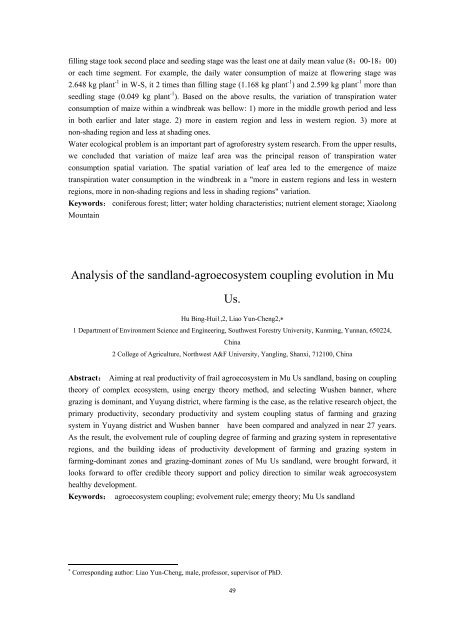Climate Change and Dryland Agricultural Ecosystem Management
Climate Change and Dryland Agricultural Ecosystem Management
Climate Change and Dryland Agricultural Ecosystem Management
Create successful ePaper yourself
Turn your PDF publications into a flip-book with our unique Google optimized e-Paper software.
filling stage took second place <strong>and</strong> seeding stage was the least one at daily mean value (8:00-18:00)<br />
or each time segment. For example, the daily water consumption of maize at flowering stage was<br />
2.648 kg plant -1 in W-S, it 2 times than filling stage (1.168 kg plant -1 ) <strong>and</strong> 2.599 kg plant -1 more than<br />
seedling stage (0.049 kg plant -1 ). Based on the above results, the variation of transpiration water<br />
consumption of maize within a windbreak was bellow: 1) more in the middle growth period <strong>and</strong> less<br />
in both earlier <strong>and</strong> later stage. 2) more in eastern region <strong>and</strong> less in western region. 3) more at<br />
non-shading region <strong>and</strong> less at shading ones.<br />
Water ecological problem is an important part of agroforestry system research. From the upper results,<br />
we concluded that variation of maize leaf area was the principal reason of transpiration water<br />
consumption spatial variation. The spatial variation of leaf area led to the emergence of maize<br />
transpiration water consumption in the windbreak in a "more in eastern regions <strong>and</strong> less in western<br />
regions, more in non-shading regions <strong>and</strong> less in shading regions" variation.<br />
Keywords: coniferous forest; litter; water holding characteristics; nutrient element storage; Xiaolong<br />
Mountain<br />
Analysis of the s<strong>and</strong>l<strong>and</strong>-agroecosystem coupling evolution in Mu<br />
Us.<br />
Hu Bing-Hui1,2, Liao Yun-Cheng2,∗<br />
1 Department of Environment Science <strong>and</strong> Engineering, Southwest Forestry University, Kunming, Yunnan, 650224,<br />
China<br />
2 College of Agriculture, Northwest A&F University, Yangling, Shanxi, 712100, China<br />
Abstract: Aiming at real productivity of frail agroecosystem in Mu Us s<strong>and</strong>l<strong>and</strong>, basing on coupling<br />
theory of complex ecosystem, using energy theory method, <strong>and</strong> selecting Wushen banner, where<br />
grazing is dominant, <strong>and</strong> Yuyang district, where farming is the case, as the relative research object, the<br />
primary productivity, secondary productivity <strong>and</strong> system coupling status of farming <strong>and</strong> grazing<br />
system in Yuyang district <strong>and</strong> Wushen banner have been compared <strong>and</strong> analyzed in near 27 years.<br />
As the result, the evolvement rule of coupling degree of farming <strong>and</strong> grazing system in representative<br />
regions, <strong>and</strong> the building ideas of productivity development of farming <strong>and</strong> grazing system in<br />
farming-dominant zones <strong>and</strong> grazing-dominant zones of Mu Us s<strong>and</strong>l<strong>and</strong>, were brought forward, it<br />
looks forward to offer credible theory support <strong>and</strong> policy direction to similar weak agroecosystem<br />
healthy development.<br />
Keywords: agroecosystem coupling; evolvement rule; emergy theory; Mu Us s<strong>and</strong>l<strong>and</strong><br />
∗ Corresponding author: Liao Yun-Cheng, male, professor, supervisor of PhD.<br />
49












